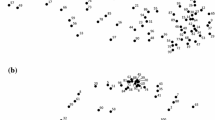Abstract
When applying smallest space analysis to behavioural science data, we may observe a radex structure in the two-dimensional output. This study proposes a method to support the investigation of the radex. A radex structure includes both polar and modular facets as defined in facet theory, where the modular facet of the concentric circles represents the frequency of variables. The polar facet of the pie shape, intersected by lines emanating from the centre, represents the semantic theme, grouped by variable clusters. When a dataset of dichotomous variables is analysed in this type of structure, variables with a higher proportion of positive answers often fall near the centre, whereas variables with a lower proportion of positive answers tend to fall near the outer area. When a few variable points fall along the line emanating from the centre to the outer rim, that series of variables may form a Guttman scale. The proposed method first determines the centre of the concentric circles, based on variable frequencies, using the quasi-Newton method of optimisation. Next, weighted Loevinger’s homogeneity coefficients (\(H_{w}\)) are used to measure the degree of Guttman scalability. The author examined possible borders among the regions of the polar facet by investigating the peaks and troughs of \(H_{w}\) values, using different ways of weighting homogeneity coefficients. Applications of the method to artificial and survey data showed that the proposed method was adequately effective for detecting the centre of concentric circles and radial lines to suggest regionality for the polar facet in a radex.







Similar content being viewed by others
References
Alison, L.J., Snook, B., Stein, K.L.: Unobtrusive measurement: using police information for forensic research. Qual. Res. 1, 241–254 (2001)
Borg, I., Shye, S.: Facet Theory: Form and Content. Sage, Thousand Oaks (1995)
Canter, D. (ed.): Facet Theory: Approaches to Social Research. Springer, New York (1985)
Canter, D.: Offender profiling and criminal differentiation. Legal Criminol. Psych. 5, 23–46 (2000)
Canter, D.V., Bennell, C., Alison, L.J., Reddy, S.: Differentiating sex offences: a behaviorally based themantic classification of stranger rapes. Behav. Sci. Law 21, 157–174 (2003)
Clogg, C.C., Sawyer, D.O.: A comparison of alternative models for analyzing the scalability of response patterns. Sociol. Methodol. 12, 240–280 (1981)
Coxon, A.P.M.: User’s Guide to Multidimensional Scaling. Heinemann, London (1982)
Guttman, L.: A basis for scaling qualitative data. Am. Sociol. Rev. 9, 139–150 (1944)
Guttman, L.: A new approach to factor analysis: the radex. In: Lazarsfeld, P.F. (ed.) Mathematical Thinking in the Social Sciences, pp. 258–348. The Free Press, New York (1954)
Guttman, L.: A general nonmetric technique for finding the smallest coordinate space for a configuration of points. Psychometrika 33, 469–506 (1968)
Guttman, R., Greenbaum, C.W.: Facet theory: its development and current status. Eur. Psychol. 3, 13–36 (1998)
Jaccard, P.: Nouvelles recherches sur la distribution florale. Bull. Soc. Vaud. Sci. Nat. 44, 223–271 (1908)
Kimura, M., Manabe, K., Yasunaga, S., Yokota, K.: Fasetto riron to kaiseki jirei: Koudou kagaku ni okeru kasetsu kensho, tansakugata bunseki shuhou [Facet theory and cases of its application: An analysis method for hypothesis testing and data exploration]. Nakanishiya, Kyoto (2002)
Loevinger, J.: The technique of homogeneous tests compared with some aspects of “scale analysis” and factor analysis. Psychol. Bull. 45, 507–529 (1948)
Shye, S., Elizur, D., Hoffman, M.: Introduction to Facet Theory: Content Design and Intrinsic Data Analysis in Behavioural Research. Sage, Thousand Oaks (1994)
van Schuur, W.H.: Ordinal Item Response Theory: Mokken Scale Analysis. Sage, Thousand Oaks (2011)
Yokota, K., Canter, D.: Burglars’ specialisation: development of a thematic approach in investigative psychology. Behaviormetrika 31, 153–167 (2004)
Acknowledgments
This study was carried out under the supervision of Associate Professor Takahiro Tsuchiya of the Institute of Statistical Mathematics. The collection of the survey data used in this study was supported by KAKENHI, the Grant-in Aid for Young Scientists (B) (No. 20730466), from the Ministry of Education, Culture, Sports, Science and Technology (MEXT) of Japan.
Author information
Authors and Affiliations
Corresponding author
Rights and permissions
About this article
Cite this article
Miyadera, T. An examination of regionality in a configuration of smallest space analysis using Loevinger’s homogeneity coefficient. Qual Quant 49, 1203–1218 (2015). https://doi.org/10.1007/s11135-014-0043-6
Published:
Issue Date:
DOI: https://doi.org/10.1007/s11135-014-0043-6




